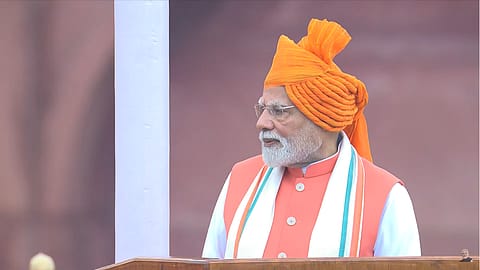GST 2.0 to give ₹1.3 lakh crore boost to select sectors
Kotak Securities estimates a major fillip to select sectors.

Prime Minister Narendra Modi, in his Independence Day speech, announced GST reforms that would help the common man, as these reforms would bring down the costs of everyday items. As per reports, the new GST tax slabs will consist of 5% and 18% rates only, with goods taxed at 12% and 28% likely to be redistributed between these two slabs. A select few items may continue to attract special rates, presumably equivalent to the current GST rate plus compensation cess.
As per data in a report by Kotak Securities, the Total GST collected was ₹22.1 trillion for FY2025. The biggest sectoral contributors were metals (₹1.25 trillion, 5.6%), cement (₹716 billion, 3.2%), non-life insurance (₹566 billion, 2.6%), telecom (₹422 billion, 1.9%), and automobiles (nearly ₹2 trillion, ~9% of GST collections). Some of these sectors are in focus in the upcoming GST reforms.
As per the said report, mass consumption and aspirational goods will likely move to lower rates, resulting in a rate reduction for select autos, cement, consumer durables and staples. This could translate to an estimated economic boost of around ₹1.3 trillion or ₹1.3 lakh crore to select sectors. The actual boost could be higher if the entire 12% slab gets subsumed in 5%. As per the report, the cement sector may not see huge benefits due to low price elasticity, as the share of cement in overall real estate prices is not very high, since land costs have a predominance in overall real estate prices.
With a reduction in prices of everyday goods, there looms a risk of a potential revenue fall. But according to analysts, the central government could offset the revenue shortfall by utilising compensation cess collections, hiking excise duties while keeping retail prices unchanged or by diverting funds from select schemes.
The report also suggests that the impact on demand of goods and the profitability of companies could depend on the market dynamics of a sector and government action. For the common man to enjoy the GST cuts, companies should pass on the lower rates through lower prices. This could risk profit margins, and to protect their interests, companies may take price hikes before the anticipated GST rate cuts in the second half of FY26 or aggressive price hikes in FY27.
Meanwhile, all ‘sin goods’, like tobacco and luxury items, SUVs, alcohol and even gaming could attract a flat 40% tax.
Previous attempts by the government to boost consumption demand or investment through tax cuts (income tax cut in the FY26 budget, corporate tax cut in September 2019) have not had the intended outcomes. But whether GST 2.0 can truly revive India’s consumption engine will depend less on rate rationalisation and more on how effectively benefits reach consumers.